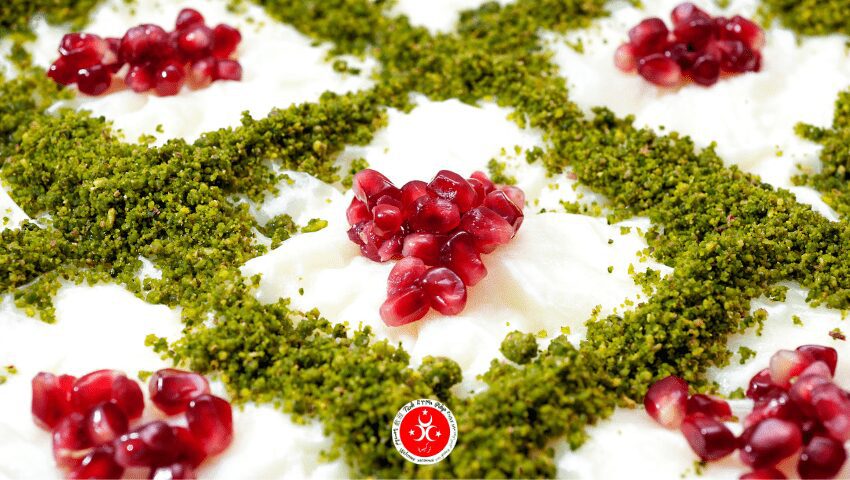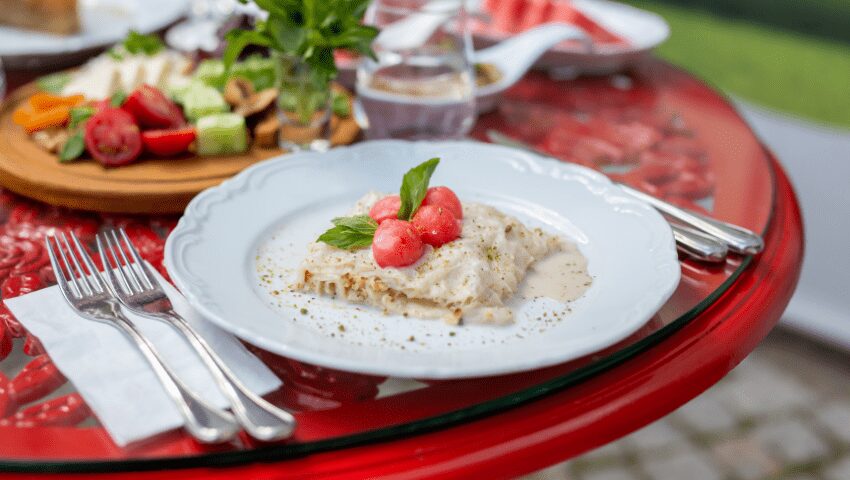Table of Contents
Gullac, which retains its place on iftar tableware, accompanying tea hours after eating, is suitable for the taste of many.
It reminds us of the very old times with the history of Gullac, which is a beloved dessert and consumed more often in the month of Ramadan every year. We have compiled for you in this article everything you are curious about Gullac and you need to know.

What is Gullac
Gullaç is one of the most special desserts of Turkish cuisine. It is known as “güllaç”, since it is a dish (aş), which is used rose water (gül) during its preparation. The main ingredient of Gullac is corn starch and flour. Sometimes when preparing Gullac, egg whites can also be added to it.
One of the first things that comes to mind when it comes to Ramadan is the elegant image of the pomegranate laugh and the fragrance that refreshes the inside of man.
This light and tasty dessert, named after Gullac, has been the sought-after taste of Ramadan tableware when passed from language to language over time. As for the time of Iftar, fasting can’t wait as much as food.
Gullac become the most impeccable when made with walnuts. It is formed by arranging the specially opened gullaç phyllo dough on a tray after it is wetted with sugar milk, and walnuts are sprinkled between the layers.
Güllaç is consumed after iftar tableware with elegant presentation and light aroma left on palates.
The Gullac, which became a whole with the month of Ramadan, was taken as a gift to Iftara guest houses in very ancient times. The tastes of this dessert are intensely rose-water aroma. Because the syrup contains rose water, but rose water is not a must-have material for a Gullac.
Also read: Ramadan in Turkey

History of Gullac
As much as the question of what is Gullac, the story of this dessert is curious. The history of Gullac dessert dates back to very ancient years. Gullac was opened in 1489 in Ottoman cuisine. Güllaç was originally presented as a baklava.
The leaves, which are used at the preparatory stage of this dessert, are called “varak”. Varaks are left over at Ali Usta from Kastamonu. In order not to waste these pastries, they wet them with sherbet with sugar and rose water and prepare a dessert.
He serves the dessert he prepared to the palace officers who come to Kastamonu. He prepares this Gullac dessert many times, which is very much appreciated and curious after his devotion. The palace officers, who liked the dessert, took Kastamonulu Ali Usta to the palace. Kastamonulu Ali Usta, who served as the head of dessert in the palace, serves as the person responsible for both Gullac and other desserts.
The master, who prepares desserts after each dinner, serves for the palace the Gullac dessert, which he prepared as a light dessert, especially after Ramadan tableware. When examining the records of palace cuisine, it is worth noting that between 1642 and 1654, 10300 sheets were taken. This dessert is very much appreciated in the palace.
Today, Gullac dessert with a culture from the Ottoman Empire is necessarily prepared in every Ramadan.
When examining the history of Gullac , every dish is not easily appreciated even in the palace table increases the value of this dessert by fold.

Why is Gullac Made in Ramadan
When the month of Ramadan arrives, the eyes look for the Gullac. This dessert is a dessert that is made in any period but is sought after Ramadan tableware even more appetite. Gullac dessert is so important in the ramadan menus of restaurants and houses. So why is it known that it is consumed only in the month of Ramadan What is the feature that stands out Gullac among Ramadan sweets
According to nutritionists, if you consume high-calorie sweets after iftar tableware, your blood sugar, which falls under the influence of fasting, may suddenly rise too much. It is recommended to be consumed in ramadan, since Gullac is a dessert that soothes nerves, balances blood sugar.
Thanks to the benefits of the Gullac, you will have eaten sweet after iftar tableware without tiring your stomach. Gullac, which contains vitamins B and E, is consumed as a dessert that prevents heartburn, as it also retains stomach enzymes.
Gullac Recipe
- 12 varak (leaves) of Gullac
- 1.5 liters of milk
- 2 cups sugar
- Drawn walnuts
- 2 tablespoons rose water (as per request)
For the top:
- Powder Pistachio
- Cherry confectionery or pomegranate
How to Make Gullac
To make Gullac dessert; we first warm it by taking milk and sugar into the saucepan, the sugars completely dissolve. At this stage you do not need to heat the milk too much, it will be enough to melt sugar.
Then we leave the milk to warm at room temperature. If the temperature of the milk does not burn your hand, you do not need to wait any longer. If the milk boils, your dessert will be dough, so it should be so that the hand does not burn.
We put the first leaf on a deep tray so that the bright part of the Gullac leaf is on top. On it we pour one or two ladle of milk so that they are wet all over. Let’s repeat the same procedure for six Gullac leaves, and after soaking the 6th layer, we sprinkle this floor with walnuts and make the same process for the other six Gullac leaves too.
In the remaining candied milk, add 2 tablespoons of rose water and let’s walk over the dessert. You should pay attention to the fact that the rose water you use here is not a cosmetic product. Let the prepared dessert keep in the refrigerator for about 2 hours.
After rest for at least 2-3 hours, you can serve, decorating it accordingly. I decorated with powdered pistachios and cherry confectionery. Bon appetit!

How many calories is Gullac
1 slice of Gullac of medium size roughly coincide with 250 calories.
Gullac Recipe
This delicious dessert, which retains its place on iftar tableware, accompanying tea hours after eating, is suitable for the taste of many. It reminds us of the very old times with the history of Gullac, which is a beloved dessert and consumed more often in the month of Ramadan every year. We have compiled for you in this article everything you are curious about Gullac and you need to know.
Type: Dessert
Cuisine: Turkish
Keywords: gullac,gullaç,güllac tarifi,gullac tatlisi,gullac yapragi
Recipe Yield: 6-8 servings
Calories: 1 slice of Gullac of medium size roughly coincide with 250 calories.
Preparation Time: PT10M
Cooking Time: PT15M
Total Time: PT25M
Recipe Ingredients:
Recipe Instructions: To make Gullac dessert; we first warm it by taking milk and sugar into the saucepan, the sugars completely dissolve. At this stage you do not need to heat the milk too much, it will be enough to melt sugar. Then we leave the milk to warm at room temperature. If the temperature of the milk does not burn your hand, you do not need to wait any longer. If the milk boils, your dessert will be dough, so it should be so that the hand does not burn. We put the first leaf on a deep tray so that the bright part of the Gullac leaf is on top. On it we pour one or two ladle of milk so that they are wet all over. Let's repeat the same procedure for six Gullac leaves, and after soaking the 6th layer, we sprinkle this floor with walnuts and make the same process for the other six Gullac leaves too. In the remaining candied milk, add 2 tablespoons of rose water and let's walk over the dessert. You should pay attention to the fact that the rose water you use here is not a cosmetic product. Let the prepared dessert keep in the refrigerator for about 2 hours. After rest for at least 2-3 hours, you can serve, decorating it accordingly. I decorated with powdered pistachios and cherry confectionery. Bon appetit!
5

